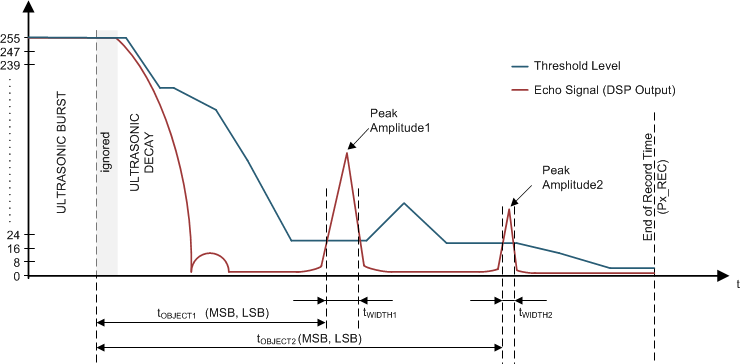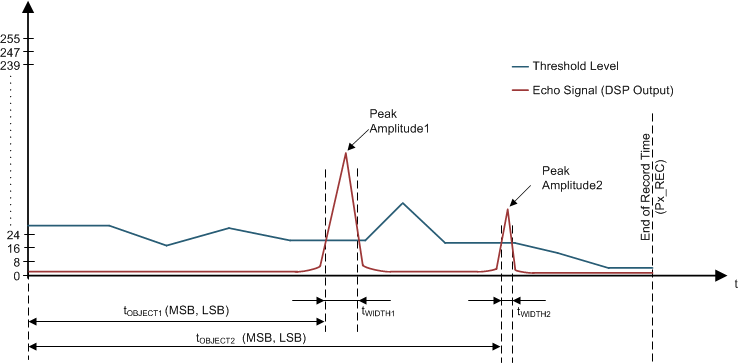SLASEJ4C April 2017 – February 2023 PGA460
PRODUCTION DATA
- 1 Features
- 2 Applications
- 3 Description
- 4 Revision History
- 5 Pin Configuration and Functions
-
6 Specifications
- 6.1 Absolute Maximum Ratings
- 6.2 ESD Ratings
- 6.3 Recommended Operating Conditions
- 6.4 Thermal Information
- 6.5 Internal Supply Regulators Characteristics
- 6.6 Transducer Driver Characteristics
- 6.7 Transducer Receiver Characteristics
- 6.8 Analog to Digital Converter Characteristics
- 6.9 Digital Signal Processing Characteristics
- 6.10 Temperature Sensor Characteristics
- 6.11 High-Voltage I/O Characteristics
- 6.12 Digital I/O Characteristics
- 6.13 EEPROM Characteristics
- 6.14 Timing Requirements
- 6.15 Switching Characteristics
- 6.16 Typical Characteristics
-
7 Detailed Description
- 7.1 Overview
- 7.2 Functional Block Diagram
- 7.3
Feature Description
- 7.3.1 Power-Supply Block
- 7.3.2 Burst Generation
- 7.3.3 Analog Front-End
- 7.3.4 Digital Signal Processing
- 7.3.5 System Diagnostics
- 7.3.6
Interface Description
- 7.3.6.1 Time-Command Interface
- 7.3.6.2
USART Interface
- 7.3.6.2.1 USART Asynchronous Mode
- 7.3.6.2.2 One-Wire UART Interface
- 7.3.6.2.3 Ultrasonic Object Detection Through UART Operations
- 7.3.6.3 In-System IO-Pin Interface Selection
- 7.3.7 Echo Data Dump
- 7.3.8 Low-Power Mode
- 7.3.9 Transducer Time and Temperature Decoupling
- 7.3.10 Memory CRC Calculation
- 7.3.11 Temperature Sensor and Temperature Data-Path
- 7.3.12 TEST Pin Functionality
- 7.4 Device Functional Modes
- 7.5 Programming
- 7.6 Register Maps
- 8 Application and Implementation
- 9 Device and Documentation Support
- 10Mechanical, Packaging, and Orderable Information
Package Options
Mechanical Data (Package|Pins)
- PW|16
Thermal pad, mechanical data (Package|Pins)
Orderable Information
7.3.6.2.3 Ultrasonic Object Detection Through UART Operations
The PGA460 UART interface has the capability to record up to 8 objects that would cut the assigned threshold. The result is expressed as a 1-µs interval time value from the time when the burst stage is complete and the echo signal drops below the assigned threshold to the moment when any of the detected objects cut the assigned threshold again. Additionally, the width of the echo signal that cuts the threshold and the peak amplitude of the object is also measured and reported. If the object is detected at the end of record time, then object width is reported as 0xFF.The width of the echo that cuts the threshold is expressed as 4-µs interval-time values. When a LISTEN ONLY command is used, the object detection starting point is at the start time of the record interval. #X7654 and #X993 show an example of two objects being detected with BURST/LISTEN and LISTEN ONLY commands, respectively. Object detection cannot occur when the DATADUMP_EN bit is set to 1.
 Figure 7-30 UART Object Detection Signaling With Burst and Listen Command
Figure 7-30 UART Object Detection Signaling With Burst and Listen Command Figure 7-31 UART Object Detection Signaling With LISTEN ONLY Command
Figure 7-31 UART Object Detection Signaling With LISTEN ONLY CommandThe comparison is done between the assigned threshold and the amplitude of the signal at the output of the DSP data path. If the threshold level is higher in value than the signal amplitude then no object is being detected. If the signal amplitude is higher in value than the threshold level denoting an echo reflection then an object is detected and the time-mark is captured. When the record time reaches the end of the record defined by the Px_REC parameters and the number of objects to be detected is still not achieved, the record interval is complete and the undetected object locations are assigned a value of 0xFF. At this point the device is ready for the next command which should be USART command 5. In case the number of objects to be detected is fulfilled before the end of record interval, the device interrupts the record cycle because the number of objects has already been detected and the device is ready for command 5. Issuing command 5 before issuing command 0 to 4 provides unpredictable data.
The following example shows how to use the PGA460 UART commands for object detection:
- On PGA460 power up, the controller configures the following:
- EEPROM by using the EEPROM bulk write command
- Time-varying gain by using the time-varying gain bulk write command
- Threshold parameters by using the threshold bulk write command or by independently writing to a particular parameter by using the register write command
- When the PGA460 device has been configured, the controller issues a run command with any of the following commands:
- BURST/LISTEN (Preset1)
- BURST/LISTEN (Preset2)
- LISTEN ONLY (Preset1)
- LISTEN ONLY (Preset2)
Following a successful receive of any of the these run commands the PGA460 device immediately runs the requested action.
- When the record interval has expired, the controller can issue the ultrasonic measurement result command to collect the data from the PGA460 device.